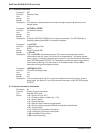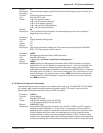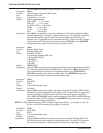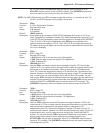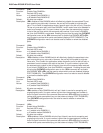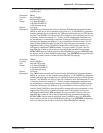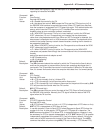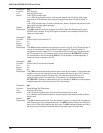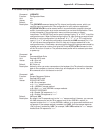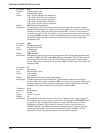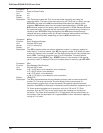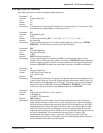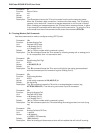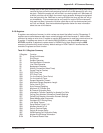
RASFinder RF300E/RF310E User Guide
RF300E/RF310E132
Command: &Sn
Function: DSR Control
Unit: Decimal ASCII code
Values: n=0—DSR is always high.
n=1—DSR acts normally; that is, it follows the state of the CD signal, which goes
high when the TA detects a carrier signal, and goes low when the carrier signal is
lost.
n=2—DSR is always high, except on disconnect, when it drops for the period of time
set by S10 and then goes high again.
Default: &S1 (DSR normal)
Description: The &Sn command controls the state of the DSR (Data Set Ready) signal on the
RS232E/V.24 interface. A high DSR signal indicates to the computer that the TA is
ready to transmit data.
Command: !SW
Function: Switch Serial Port Control to TA
Unit: n/a
Values: n/a
Default: n/a
Description: The !SW command switches the serial port control to the TA. If the TA was already in
control of the serial port, then the TA will simply report OK. Once the switch is
complete the port will report OK. This command should be the only command given
per AT command line. For example, only give the command AT!SW<CR>. Results
for commands on the line following !SW may not be properly handled especially if
switching from the modem to the TA.
Command: *!SW
Function: Switch Serial Port Control to Modem
Unit: n/a
Values: n/a
Default: n/a
Description: The *!SW command switches the serial port control to the modem. If the modem was
already in control of the serial port, then the modem will simply report OK. Once the
switch is complete the port will report OK. This command should be the only
command given per AT command line. For example, only give the command
AT*!SW<CR>. Results for commands on the line following *!SW may not be properly
handled especially if switching from the TA to the modem.
Command: #Xn
Function: Send Multiple Xoff Characters
Unit: Decimal ASCII code
Values: n=0—One Xoff character sent until the buffer reaches the Xon level
n=1—Multiple Xoff characters sent for everycharacter received after buffer reaches
the full level.
Default: #X0
Description: The #Xn command allows the TA to send either a single or multiple Xoff characters to
exert flow control to the computer/terminal. The #X0 command causes one Xoff to be
sent until the TA’s buffer reaches the Xon level. The #X1 command causes an Xoff to
be sent for every character received after the TA reaches its full buffer level.



